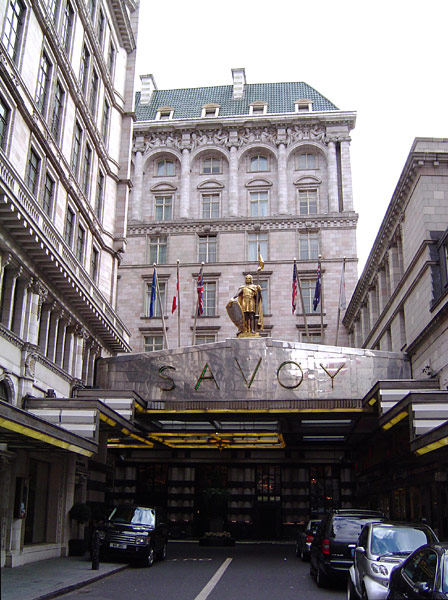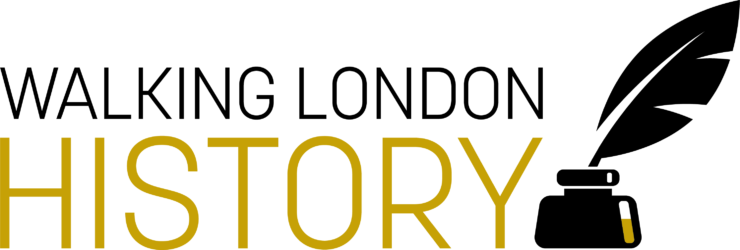Friday, 9th September 2pm
Take the afternoon off work and enjoy a fascinating tour of one of London’s most attractive areas.
The Remarkable Women of Marylebone
Lots more walks available.
Last week’s blog posed a riddle: what links a cat; Henry III; comic opera; the Highway Code; and Henry VII?

The answer is The Savoy.
In 1236 Henry III married Eleanor of Provence who invited her relatives to England, including Peter of Savoy. Peter acquired the land around the current hotel from the king in 1245 and constructed Savoy Palace in 1263. There is a statue of Peter of Savoy over the entrance to the hotel.
Later owned by John of Gaunt, the third son of Edward III, the palace was largely destroyed in the peasant’s revolt of 1381 and the remains became a prison. In 1505 Henry VII built a ‘hospital’ on the site for the ‘poor and needy’. Later used as a barracks and a prison, it was gradually destroyed by the construction of both Waterloo Bridge in 1817 and the Embankment in the 1860s. Only the hospital chapel remains, now called the Queen’s Chapel of the Savoy. This was pictured in last week’s post.
In 1881 Richard d’Oyly Carte acquired the site and built the Savoy Theatre specifically for the comic operas of Gilbert and Sullivan. The three men famously fell out over the funding of a carpet but their enormous financial success enabled D’Oyly Carte to build the magnificent Savoy hotel in 1889.
The High way Code? The entrance road to the hotel is often identified as the only road in London on which you drive on the right (or wrong) side of the road.
And the cat?! In 1898, a wealthy South African named Woolf Joel hosted a private dinner at the hotel. Thirteen people gathered for dinner and guests discussed the superstition associated with the unlucky number, suggesting that the first person to get up from the table would be the first to die. Scoffing at the superstition, Woolf Joel left the table first. Back home in Johannesburg a few weeks later, Joel was shot dead.
As a result the Savoy decreed that in future any table of thirteen would be joined by a member of staff as a fourteenth guest, and for the next twenty-five years a waiter would sit at the table if there were 13 guests. The presence of a complete stranger at the table was unpopular with guests and the hotel had one less waiter available. An alternative approach was required. The solution was Kaspar the Cat, sculpted in the 1920s, who now, when required, sits silently on the fourteenth chair with a napkin around his neck, and is served with each course along with the other thirteen guests. Visitors can see Kaspar on a cabinet in the main reception area of the hotel.
Another tasty morsel: An early chef at the Savoy was Auguste Escoffier. It is often said that the word ‘to scoff’, as in ‘to scoff your food’, derives from his name. Unfortunately it appears the word was already in use by the middle of the 19th century and derives from ‘scarf’ which was probably an Africaan or Dutch word for food. But why ruin a good story?!
This week’s question: which building in the Borough of Westminster connects these people, and many more?!
Althorp, Lord, later third Earl Spencer
Armstrong-Jones, A. C. R., later Earl of Snowdon
Lord Byron, poet
Clark, Sir Kenneth, Chairman of the Arts Council, broadcaster
Gladstone, William Ewart, statesman
Hamilton, Patrick, novelist and playwright
Kinnaird, Arthur, M.P. and footballer
Macaulay, Thomas Babington, historian
Muggeridge, Malcolm, journalist
Smirke, (Sir) Robert, architect
Edward Heath, Prime Minister
Stanley, Lord, M.P., later fifteenth Earl of Derby, Prime Minister
Isaiah Berlin, philosopher
Bill Nighy, Actor
Edward de Bono, psychologist, philosopher
Alan Clark MP
Norman Foster, architect
Georgette Heyer, writer
Dame Edith Evans, actor
Jacob Rees Mogg, MP
Send your answer via comments!
